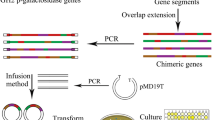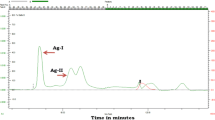Abstract
Variants of β-galactosidase with Valine and with Glutamine replacing Glutamate-416 did not have a Mg2+ bound at the active site even at high Mg2+ concentrations (200 mM). They had low catalytic activity and the pH profiles were very different from those of the native enzyme. In addition, substrates, substrate analogs, transition state analogs and galactose bound very poorly. However, the orientation and conformation of the Mg2+ ligands (residues 416, 418, and 461) as well as the B-factors of these three side chains did not change significantly. The structures, conformations and B-factors of other active site residues were also essentially unchanged. These studies show that the active site Mg2+ is not necessary for structure and is, therefore, mainly important for modulating the chemistry and mediating the interactions between the active site components.




Similar content being viewed by others
Notes
Mn2+ can substitute for Mg2+ [3] but this results in only small changes in activity and binding.
The Advanced Light Source synchrotron access program is supported by grants from the Alberta Science and Research Authority and the Alberta Heritage Foundation for Medical Research. The Advanced Light Source at Lawrence Berkeley Laboratory is operated by the Department of Energy (USA) and supported by the National Institute of Health (USA). The National Science Foundation, the University of California and Henry Wheeler fund Beamline 8.3.1.
The average B-factors for each of the residues of the enzymes were 23.7 and 21.6 for E416Q- and E416V-β-galactosidase, respectively. Totally disordered residues have B-factors of 100. Thus the ratios of the B-factors of the residues to the overall B-factors of the enzymes would be between 4 and 5 if they were in total disorder.
The [Mg2+] at which the native enzyme has half of its full activity is about 10−7 M. Thus the concentration at which these studies were done (10−4 M) were several orders of magnitude higher than the Mg2+ dissociation constant for the native enzyme.
Abbreviations
- Amp:
-
Ampicillin
- CNS:
-
Crystallographic and NMR system
- COOT:
-
Crystallographic object oriented tool kit
- DMSO:
-
Dimethyl sulfoxide
- EDTA:
-
Ethylene diamine tetra acetate
- IPTG:
-
Isopropyl-thio-β-d-galactopyranoside
- oNP:
-
o-Nitrophenol
- oNPG:
-
o-Nitrophenyl-β-d-galactopyranoside
- SDS–PAGE:
-
Sodium dodecyl sulfate–polyacrylamide gel electrophoresis
- TES:
-
N-tris[hydroxymethylmethyl-2-aminoethanesulfonic acid
References
Huber RE, Kurz G, Wallenfels K (1976) Biochemistry 15:1994–2001
Juers DH, Heightman TD, Vasella A, McCarter JD, Mackenzie L, Withers SG, Matthews BW (2001) Biochemistry 40:14781–14794
Huber RE, Parfett C, Woulfe-Flanagan H, Thompson DJ (1979) Biochemistry 18:4090–4095
Jacobson RH, Zhang XJ, DuBose RF, Matthews BW (1994) Nature 369:761–766
Sutendra G, Wong S, Fraser ME, Huber RE (2007) Biochem Biophys Res Commun 352:566–570
Juers DH, Wigley RH, Zhang X, Huber RE, Tronrud DE, Matthews BW (2000) Prot Sci 9:1685–1699
Roth NJ, Huber RE (1994) Biochem Biophys Res Commun 201:866–870
Roth NJ, Huber RE (1996) Biochem Biophys Res Commun 219:111–115
Selwood T, Sinnott ML (1990) Biochem J 268:317–323
Richard JP, Huber RE, Lin S, Heo C, Amyes TL (1996) Biochemistry 35:12377–12386
Juers DH, Rob B, Dugdale ML, Rahimzadeh N, Giang C, Lee M, Matthews BW, Huber RE (2009) Prot Sci 18:1281–1292
Evans PR (1993) Data reduction. Proceedings of CCP4 Study Weekend on Data collection and processing, pp 114–122
Kabsch W (1988) J Appl Cryst 21:916–924
Leslie AGW (1991) In: Moras D, Podjarny AD, Thierry JC (eds) Crystallographic computing 5, from chemistry to biology. Oxford University Press, Oxford
Brünger AT, Adams PD, Clore GM, DeLano WL, Gros P, Grosse-Kunstleve RW, Jiang JS, Kuszewski J, Nilges M, Pannu NS, Read RJ, Rice LM, Simonson T, Warren GL (1998) Acta Crystallogr D Biol Crystallogr 54:905–921
Emsley P, Cowtan K (2004) Acta Crystallogr D Biol Crystallogr 60:2126–2132
Winn M, Isupov M, Murshudov GN (2001) Acta Crystallogr D Biol Crystallogr D57:122–133
Deschavanne PJ, Viratelle OM, Yon JM (1978) J Biol Chem 253:833–837
Huber RE, Gaunt MT (1983) Arch Biochem Biophys 220:263–271
Acknowledgments
A grant from the Natural Sciences and Engineering Research Council of Canada to REH (#1891) is gratefully appreciated. We thank Dr. Marie Fraser (Biological Sciences, University of Calgary) for help in processing the diffraction data.
Author information
Authors and Affiliations
Corresponding author
Rights and permissions
About this article
Cite this article
Lo, S., Dugdale, M.L., Jeerh, N. et al. Studies of Glu-416 Variants of β-Galactosidase (E. coli) Show that the Active Site Mg2+ is Not Important for Structure and Indicate that the Main Role of Mg2+ is to Mediate Optimization of Active Site Chemistry. Protein J 29, 26–31 (2010). https://doi.org/10.1007/s10930-009-9216-x
Published:
Issue Date:
DOI: https://doi.org/10.1007/s10930-009-9216-x




